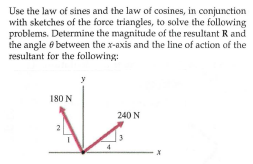Use the law of sines and the law of cosines, in conjunction with sketches of the force triangles, to solve the following problems. Determine the magnitude of the resultant R and the angle e between the x-axis and the line of action of the resultant for the following: 180 N 240 N
Use the law of sines and the law of cosines, in conjunction with sketches of the force triangles, to solve the following problems. Determine the magnitude of the resultant R and the angle e between the x-axis and the line of action of the resultant for the following: 180 N 240 N
Classical Dynamics of Particles and Systems
5th Edition
ISBN:9780534408961
Author:Stephen T. Thornton, Jerry B. Marion
Publisher:Stephen T. Thornton, Jerry B. Marion
Chapter1: Matrices, Vectors, And Vector Calculus
Section: Chapter Questions
Problem 1.16P: What surface is represented by r a = const, that is described if a is a vector of constant...
Related questions
Question

Transcribed Image Text:Use the law of sines and the law of cosines, in conjunction
with sketches of the force triangles, to solve the following
problems. Determine the magnitude of the resultant R and
the angle e between the x-axis and the line of action of the
resultant for the following:
180 N
240 N
Expert Solution
This question has been solved!
Explore an expertly crafted, step-by-step solution for a thorough understanding of key concepts.
Step by step
Solved in 4 steps with 8 images

Recommended textbooks for you

Classical Dynamics of Particles and Systems
Physics
ISBN:
9780534408961
Author:
Stephen T. Thornton, Jerry B. Marion
Publisher:
Cengage Learning

Principles of Physics: A Calculus-Based Text
Physics
ISBN:
9781133104261
Author:
Raymond A. Serway, John W. Jewett
Publisher:
Cengage Learning

University Physics Volume 1
Physics
ISBN:
9781938168277
Author:
William Moebs, Samuel J. Ling, Jeff Sanny
Publisher:
OpenStax - Rice University

Classical Dynamics of Particles and Systems
Physics
ISBN:
9780534408961
Author:
Stephen T. Thornton, Jerry B. Marion
Publisher:
Cengage Learning

Principles of Physics: A Calculus-Based Text
Physics
ISBN:
9781133104261
Author:
Raymond A. Serway, John W. Jewett
Publisher:
Cengage Learning

University Physics Volume 1
Physics
ISBN:
9781938168277
Author:
William Moebs, Samuel J. Ling, Jeff Sanny
Publisher:
OpenStax - Rice University